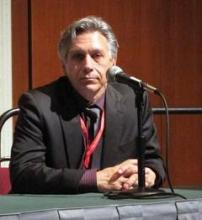HONOLULU– What if you could scan your patients for stroke-susceptibility loci or implant a device in their brains to repair stroke-damaged pathways?
Those novel approaches may sound far-fetched, but such forward-thinking concepts are achievable, according to some of the best minds in the field of stroke medicine, who put forth these and other proposals at a special session at the International Stroke Conference. To spice things up even more, session organizers limited presentations to just 5 minutes and relied on the audience in some cases to keep on schedule and enthusiastically applaud the speakers off the stage. Here are just a few of the fascinating insights offered during the session, entitled "The Next Big Thing in Stroke."
Restorative therapies
Just 2 decades after scientists demonstrated the plasticity of the brain after stroke, the restorative processes that occur after the acute phase of stroke continue to be teased out, opening up potential targets for new drugs. At the same time, neurotechnology is maturing.
"We’re very quickly entering a brave new world of neuroengineering in the brain after stroke," said Randolph J. Nudo, Ph.D., director of the Landon Center on Aging at the University of Kansas Medical Center, Kansas City.
In the emerging field of robotics, a neural interface system implanted in two humans with long-standing tetraplegia recorded neural signals from the brain as input commands to control a robotic arm (Nature 2012;485:372-5).
A miniaturized closed-loop system implanted in the cerebral cortex of brain-injured rats has been shown to improve recovery. Dr. Nudo sees the potential of these advances for neurotransmitter sensing, open-and closed-loop drug delivery, and control of stem cell integration.
Dr. Joel Stein, chair of rehabilitative and regeneration medicine at Columbia University, New York, said robotics are being used to deliver rehabilitation therapy. Exoskeletal work stations (Hocoma) incorporate engaging games or virtual reality experiences to provide a large number of repetitions for the patient without therapist fatigue. Wearable "bionic legs" (Tibion) provide external force to supplement muscle strength and improve motor skills through practice.
Not all robotics have panned out, however. In a study of veterans, robot-assisted therapy provided only modest effects on poststroke upper-limb impairment (N. Engl. J. Med. 2010;362:1772-83). The robotic therapy also was somewhat more expensive than intensive human therapy ($9,977 vs. $8,269).
Robotics are not necessarily always going to be better; but when they are equally as good as traditional approaches, they provide us with new efficiencies in terms of delivery, said Dr. Stein. "The bottom line is that robots are coming, we should prepare for them and expect them to become a key piece of clinical practice in this field in the future."
Genetics
It’s still the early days in the search for genetic susceptibility loci for stroke, but we’re getting closer, said Dr. Ralph Sacco, professor and chair of neurology at Miller School of Medicine at the University of Miami.
The collaborative METASTROKE study offered some findings. The big push now, as the cost of these studies comes down, is moving from common variants to rare variants using next-generation sequencing and even whole-genome studies.
Large family studies that use next-generation sequencing such as the National Institute of Health–supported Life After Linkage study, should also help in smaller more homogenous groups.
"We really have to refine our phenotypes using extreme phenotypes, subgroups, and subclinical traits and make sure we get the phenotype right, so all this next-generation sequencing will make sense," Dr. Sacco said.
The ability to identify rare variants may open up unknown novel pathways that could serve as targets for drug therapy. Someday, clinicians could use genetic testing to identify "at-risk" patients for ultra-early stroke prevention therapies. Pharmacogenomic profiles will be used to personalize stroke prevention treatments.
A global preemptive strike
Several speakers looked to a prevention model to reverse the exploding global burden of stroke.
Dr. Valery Feigin, director of the National Institute for Stroke and Applied Neurosciences in Auckland, New Zealand, said that priority should be given to a population-based approach that includes legislative measures aimed at environmental risk factors such as reducing salt intake – something recently introduced in some European countries.
"A very small shift in the distribution of risk factors across the population will result in a major drop in stroke incidence," he said, noting, for example, that smoking cessation alone can reduce stroke risk by 12%-19%.
The suggestion elicited a flurry of comments during the discussion period including concerns about creating a "nanny state" and a reminder of the political price that New York City Mayor Michael Bloomberg paid for trying to reduce the size of soft drinks. Still others suggested that such measures need to be positively reinforced and that there is a civil obligation to act given the massive costs of poor public health.


